The Chinese, LEDs and giant screens - a short photo report with LED China
We in Moscow are beginning to slowly ban outdoor advertising such as banners. And many owners of large buildings are already animated to order hefty LED screens for facades and roofs.
Therefore, I went to the LED China 2013 exhibition in Guangzhou with a clear understanding of what I was interested in. This is the largest LED exhibition in the world in terms of the number of exhibitors . It has been held in China for many years. Here is the venue - one of the exhibition pavilions of Guangzhou, next to 6 more with other exhibitions:
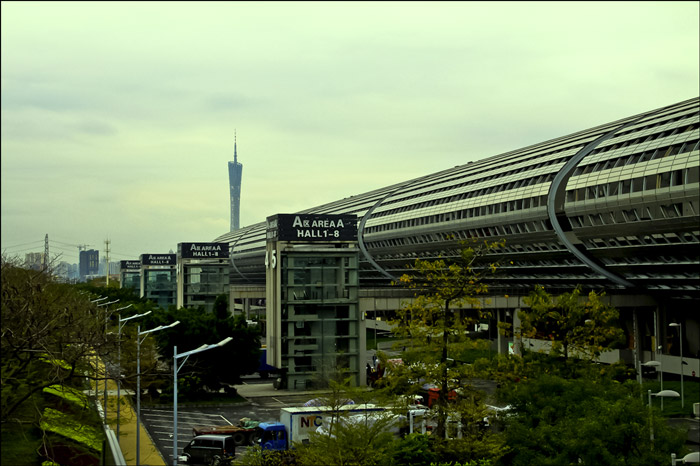
This is how the local VDNKh looks like in a Chinese city (bigger than Moscow).
')
The main language of the exhibition is English, but what pleases is already a lot of Russians. When you enter a large pavilion, they ask where you are from, and when they hear “Rashsha”, they say that there is a person who knows the language. A minute later, a specially trained Chinese man appears who really speaks Russian, but in such a way that he would not do it better. As a result, communication is still in English.
Attention, traffic : below photo report.
The exhibition is held in China because all the major manufacturers are concentrated there . There are manufacturers of iron: the screens themselves, LEDs, switching systems, lamps, and so on. Integrators come from all over the world. There is also a special pavilion of equipment for the production of screens - machines for the production of chips and the LEDs themselves. The closest in size is ISE, with which there was already a report , but it is common, and there are not so many LED technologies there.
The greatest interest for me was represented by manufacturers of screens and control equipment. By and large, all participants had a “standard set” of popular screen versions, and what was new in the breach of the year was present on many stands. As, for example, LED bulbs, in different sizes and in very large quantities.
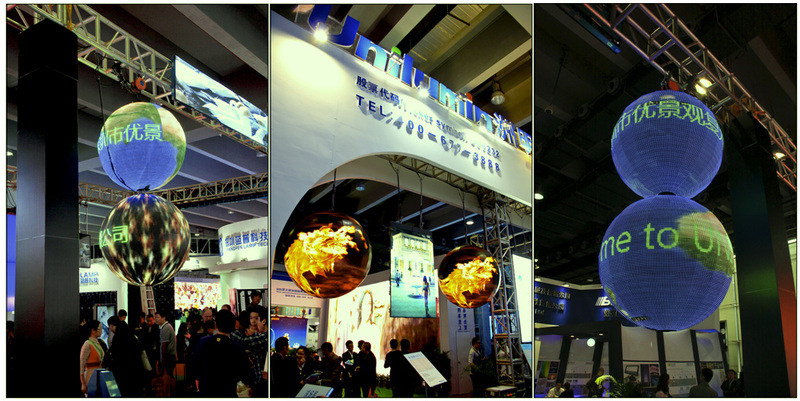
Presented in a large number of LED balls on different stands.
This year was presented a large number of different options for curved screens. Options with rigid screens, with a fixed radius and exhibited, plus grids. It can be used both to create a screen of a certain form on fixed or rental installations, as well as to cover existing perimeters. In our practice, they are often used for various static outdoor advertising and in organizing concerts.

On the left is a screen with rigid modules without fixation. On the right are the elements for setting angles on a rigid grid.
Fully-bending modules with rubber-based boards are a novelty among curved screens. Most liked the implementation of such modules from the companies Bada and EsdLumen. Such modules allow you to make a circle of screens with a very small radius. Although there will still be a question with the wiring of signals and power to such small modules. The new screen on the magnets can simply be taken and wrapped around the pillar: very convenient.

On the left is the EsdLumen rubber module. On the right - Absen rubber modules.
Among the manufacturers of screens with a small pixel pitch, the headliner was a familiar Silicon Core, who presented a small module with a pitch of 1.5 mm, on which the cartoon was spinning confidently. The rest of the company kept within 2 mm.
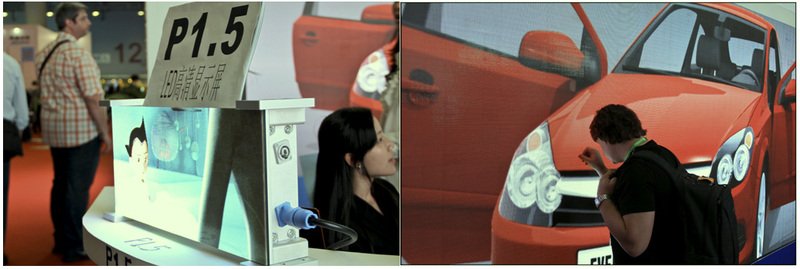
On the left is a stand-alone module P1,5mm. On the right - an inspection of the docking of the P2.5 screen cabinets.
In principle, the 1.5mm module can be called a prototype, and I believe that while everything that is less than 2.5 mm is not completely modified, the assembled screens look not displayed. On the other hand, 2.5 mm already look very high quality.

Curved Leyard screen with a step of P2,5 - P2,6, resolution 3840x1080r. Made of small rigid modules, that is, the mounting surface can be very different. In the example - the arc.
Several companies have introduced LED kiosks. The kiosks from Liantronics look good. Unfortunately, so far only indoor performances, but promised to release street ones in the near future. High brightness and resolution make the use of street kiosks very attractive for advertising and for retail. Given that they can be interactive, most likely, it is worth waiting for the moment when our retail chains see their potential.

Liantronics kiosks.
Manufacturers of control systems have 3D processors. They support normal active stereo from NVidia cards (for example) - in a timely manner, taking into account the reduction in price of indoor high-resolution screens. Theoretically, the controllers support 400Hz and above, but there are no fundamental differences from conventional stereo.

On the right is the RGBLink switching equipment, in the center is the 3D controller, on the right is the LEDWALL processors.
Several companies offer custom solutions for every taste, in particular, standalone sports boards liked - a minimum of management and functionality would be nice for small sports facilities.
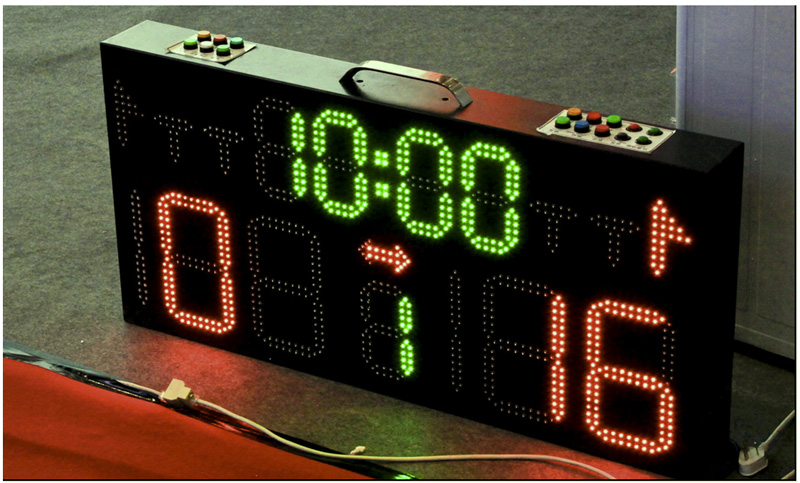
Small sports scoreboard, with a set of buttons for 4 team games.
These solutions are interesting because they are made extremely simple and for individual order. If you need a sign for a small stadium without any problems - knocking to the Chinese, we order, we get the board itself and the remote with buttons like "increase score, decrease score, turn off". You can screw the handle.
Also really liked the LED signs. They work on batteries, are charged from mini-USB, and content is pushed through it. The battery life of about 16 hours, enough for any meeting. So far, I don’t see a wide practical application, but for some reason the Chinese really like them.

At the left - a plate for individual use, on the right - plates for transport.
Another interesting application of LEDs is a frame for thin panels for video walls. A transparent silicone film with LEDs is attached to the seam between the panels and completes the missing picture. There are frames for a standard set of thin-panel panels, but I think custom options are also possible. In my opinion, it does not look quite believable, but it is better than painting the seams in the main colors of the presentation, as the customers asked me several times. The connection interface is not very simple yet (obviously not a couple of clicks and cables), but if suddenly you really need it, there is a solution.
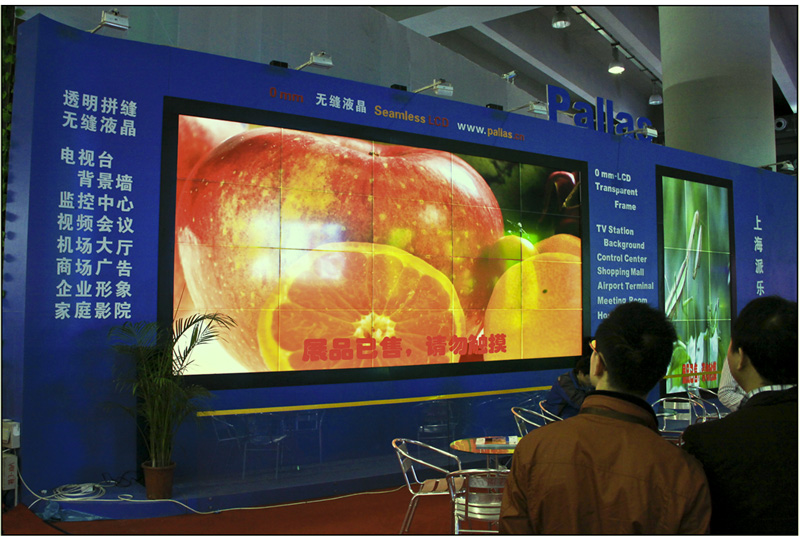
Video walls NEC 47 "with LED film on the seams.
Of the main Russian suppliers, I liked the Absen stand the most. The highest quality installation of screens, a large area and a lot of people. The screen looked the best at the exhibition because it was very smoothly displayed. In the photo, everything in orange is the staff who are ready to help. In the distance there is a bar and a Mercedes with a woman, even once they turned on Russian music. In general, taken care of.
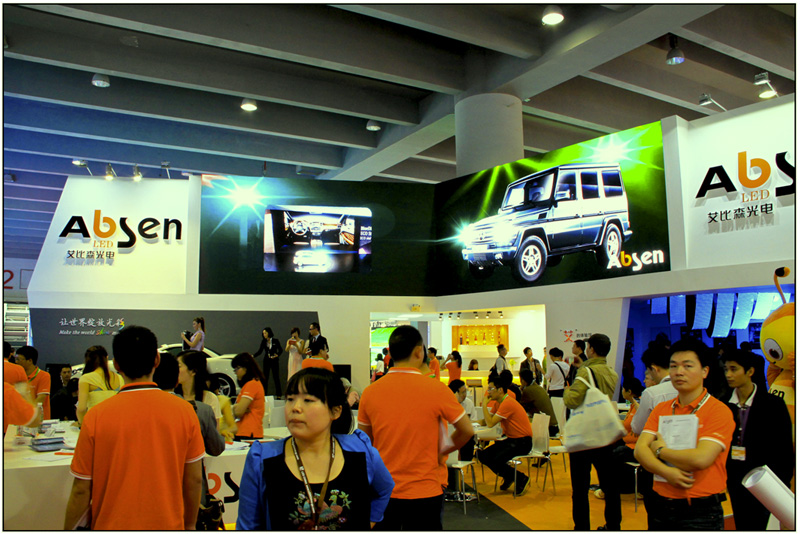
Absen company booth, located at the top of the screen with a 3.9 mm pitch.
But what was for me the most important - the grid. Among the manufacturers of grids of a wide variety was not noticed, about the same model line in pixel pitch and brightness. There was one stand of GTEK, which has a very interesting solution for a media facade on an office building.
The grid modules are assembled into rolls during the daytime, thereby providing an overview in the windows. In the evening, get a full screen. Conveniently.
How much this technology is applicable in the conditions of the Russian winter, we can only guess, we will test. Grids with a large pitch were presented only as separate modules, which, in fact, is logical, since it is impossible to assess the quality of work within the premises.

On the left is the realized Gtek motorized screen. On the right is the rental grid in 12mm increments.
I know for sure that already this year the demand for static grids will grow strongly, so it was very interesting to see all the new items live.
And finally, about the prospects for all this. For example: in China there are a lot of LEDs on the streets, and one of the brightest objects at night is the TV tower in Guangzhou:

Perhaps we, too, will be so soon.
Therefore, I went to the LED China 2013 exhibition in Guangzhou with a clear understanding of what I was interested in. This is the largest LED exhibition in the world in terms of the number of exhibitors . It has been held in China for many years. Here is the venue - one of the exhibition pavilions of Guangzhou, next to 6 more with other exhibitions:

This is how the local VDNKh looks like in a Chinese city (bigger than Moscow).
')
The main language of the exhibition is English, but what pleases is already a lot of Russians. When you enter a large pavilion, they ask where you are from, and when they hear “Rashsha”, they say that there is a person who knows the language. A minute later, a specially trained Chinese man appears who really speaks Russian, but in such a way that he would not do it better. As a result, communication is still in English.
Attention, traffic : below photo report.
The exhibition is held in China because all the major manufacturers are concentrated there . There are manufacturers of iron: the screens themselves, LEDs, switching systems, lamps, and so on. Integrators come from all over the world. There is also a special pavilion of equipment for the production of screens - machines for the production of chips and the LEDs themselves. The closest in size is ISE, with which there was already a report , but it is common, and there are not so many LED technologies there.
The greatest interest for me was represented by manufacturers of screens and control equipment. By and large, all participants had a “standard set” of popular screen versions, and what was new in the breach of the year was present on many stands. As, for example, LED bulbs, in different sizes and in very large quantities.
Let me remind you that initially the very idea of the LED screen appeared at the moment when it was necessary to carry information outside, for example, to do navigation on the roads, signs outside airports and so on. Perhaps you all remember the good old lamp signs with a score at the stadiums - this is just a prototype of modern screens.
The basic requirement was very simple - high brightness with large screen sizes and minimal cost. The technology with a ray tube (plasmas and LCD) had problems of limiting the maximum size: LCD and plasma were too expensive and low-contrast, and projectors could work adequately only at night, therefore LEDs were used. Over the years, the pixel pitch has decreased - now it is one of the main trends. A few months ago, on the ISE, for example, the screen was shown in increments of 1.9 millimeters; this exhibition already has a display in increments of 1.5 mm.
Now the screens are divided into two main types - for the street with moisture protection and resistance to the Russian winter and tropical summer, and interior - they are pover and less bright, but with minimal pixel pitch.

Presented in a large number of LED balls on different stands.
This year was presented a large number of different options for curved screens. Options with rigid screens, with a fixed radius and exhibited, plus grids. It can be used both to create a screen of a certain form on fixed or rental installations, as well as to cover existing perimeters. In our practice, they are often used for various static outdoor advertising and in organizing concerts.

On the left is a screen with rigid modules without fixation. On the right are the elements for setting angles on a rigid grid.
Fully-bending modules with rubber-based boards are a novelty among curved screens. Most liked the implementation of such modules from the companies Bada and EsdLumen. Such modules allow you to make a circle of screens with a very small radius. Although there will still be a question with the wiring of signals and power to such small modules. The new screen on the magnets can simply be taken and wrapped around the pillar: very convenient.

On the left is the EsdLumen rubber module. On the right - Absen rubber modules.
Among the manufacturers of screens with a small pixel pitch, the headliner was a familiar Silicon Core, who presented a small module with a pitch of 1.5 mm, on which the cartoon was spinning confidently. The rest of the company kept within 2 mm.

On the left is a stand-alone module P1,5mm. On the right - an inspection of the docking of the P2.5 screen cabinets.
In principle, the 1.5mm module can be called a prototype, and I believe that while everything that is less than 2.5 mm is not completely modified, the assembled screens look not displayed. On the other hand, 2.5 mm already look very high quality.

Curved Leyard screen with a step of P2,5 - P2,6, resolution 3840x1080r. Made of small rigid modules, that is, the mounting surface can be very different. In the example - the arc.
Several companies have introduced LED kiosks. The kiosks from Liantronics look good. Unfortunately, so far only indoor performances, but promised to release street ones in the near future. High brightness and resolution make the use of street kiosks very attractive for advertising and for retail. Given that they can be interactive, most likely, it is worth waiting for the moment when our retail chains see their potential.

Liantronics kiosks.
Manufacturers of control systems have 3D processors. They support normal active stereo from NVidia cards (for example) - in a timely manner, taking into account the reduction in price of indoor high-resolution screens. Theoretically, the controllers support 400Hz and above, but there are no fundamental differences from conventional stereo.

On the right is the RGBLink switching equipment, in the center is the 3D controller, on the right is the LEDWALL processors.
Several companies offer custom solutions for every taste, in particular, standalone sports boards liked - a minimum of management and functionality would be nice for small sports facilities.

Small sports scoreboard, with a set of buttons for 4 team games.
These solutions are interesting because they are made extremely simple and for individual order. If you need a sign for a small stadium without any problems - knocking to the Chinese, we order, we get the board itself and the remote with buttons like "increase score, decrease score, turn off". You can screw the handle.
Also really liked the LED signs. They work on batteries, are charged from mini-USB, and content is pushed through it. The battery life of about 16 hours, enough for any meeting. So far, I don’t see a wide practical application, but for some reason the Chinese really like them.

At the left - a plate for individual use, on the right - plates for transport.
Another interesting application of LEDs is a frame for thin panels for video walls. A transparent silicone film with LEDs is attached to the seam between the panels and completes the missing picture. There are frames for a standard set of thin-panel panels, but I think custom options are also possible. In my opinion, it does not look quite believable, but it is better than painting the seams in the main colors of the presentation, as the customers asked me several times. The connection interface is not very simple yet (obviously not a couple of clicks and cables), but if suddenly you really need it, there is a solution.

Video walls NEC 47 "with LED film on the seams.
Of the main Russian suppliers, I liked the Absen stand the most. The highest quality installation of screens, a large area and a lot of people. The screen looked the best at the exhibition because it was very smoothly displayed. In the photo, everything in orange is the staff who are ready to help. In the distance there is a bar and a Mercedes with a woman, even once they turned on Russian music. In general, taken care of.

Absen company booth, located at the top of the screen with a 3.9 mm pitch.
But what was for me the most important - the grid. Among the manufacturers of grids of a wide variety was not noticed, about the same model line in pixel pitch and brightness. There was one stand of GTEK, which has a very interesting solution for a media facade on an office building.
The grid modules are assembled into rolls during the daytime, thereby providing an overview in the windows. In the evening, get a full screen. Conveniently.
How much this technology is applicable in the conditions of the Russian winter, we can only guess, we will test. Grids with a large pitch were presented only as separate modules, which, in fact, is logical, since it is impossible to assess the quality of work within the premises.

On the left is the realized Gtek motorized screen. On the right is the rental grid in 12mm increments.
I know for sure that already this year the demand for static grids will grow strongly, so it was very interesting to see all the new items live.
And finally, about the prospects for all this. For example: in China there are a lot of LEDs on the streets, and one of the brightest objects at night is the TV tower in Guangzhou:

Perhaps we, too, will be so soon.
Source: https://habr.com/ru/post/174505/
All Articles